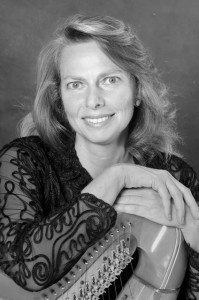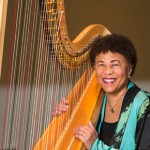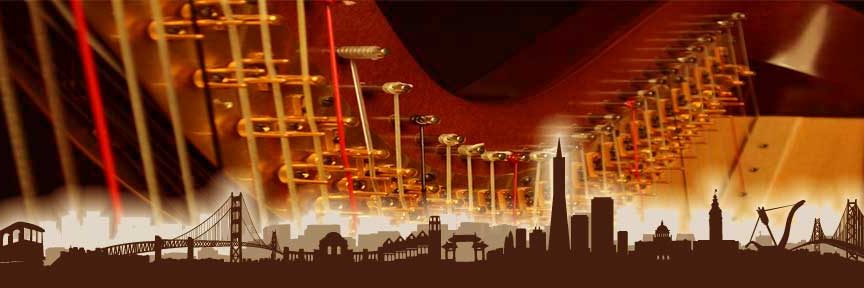Tips for Harpists, Member Spotlight, & More
 Dear BACAHS Members and Friends:
Dear BACAHS Members and Friends:
Our November newsletter brings new announcements of harp happenings and calendar postings of which you’ll want to make note. Our feature, Member Spotlight, again showcases one of our members, this time new board member David J. Trapp.
Read about our wildly successful Ann Hobson Pilot event, which kicked off our new season. Don’t miss the launch of Practical Tips for Harpists – a new on-going column by member, harpist and harp technician, Karen Gottlieb, where she explores Cleaning and Preserving the Beauty of your Harp’s Finish.
We hope viewing Member News will inspire you to check in with us and share your harp pursuits with the local harp community. We want to hear from more of you!
Look for new additions to our ever expanding BACAHS Calendar. Be sure to take note of the date of our always popular Winter Potluck, scheduled for Sunday January 31, that will include a music swap and performance. Be sure to start culling your music for those pieces that you no longer need and might be enjoyed by others.
Without further ado, I’ll leave you to your reading pleasure.
Happy Harping!
Alice Yothers
President
MEMBER SPOTLIGHT: Meet new BACAHS Board Member, David J. Trapp
By Suki Russack
 Have you ever had a dream that you thought could never come true? BACAHS newest board member, David Trapp, had that dream, but he made it a reality with hard work and by taking a great leap into the unknown. David started playing the harp in 2001. He had no background in music but had always nursed a secret desire to play an instrument. One day while visiting Ashland, Oregon, for the Shakespeare Festival, he wandered into a music store that had several different harps for sale, and he couldn’t resist buying one of them. It was a small Dusty Strings with 26 strings. The music store owner told him that if he wanted a larger harp he could exchange the smaller instrument later. Knowing he needed a teacher, David started lessons with Verlene Schermer in San Jose. Within a month the need for a larger harp became clear, so he drove back to Ashland and exchanged the 26-string harp for a Dusty Strings 32. Within the next year, he graduated to a 36-string harp. He studied with Verlene for two years, learning how to read music and the basics of playing.
Have you ever had a dream that you thought could never come true? BACAHS newest board member, David Trapp, had that dream, but he made it a reality with hard work and by taking a great leap into the unknown. David started playing the harp in 2001. He had no background in music but had always nursed a secret desire to play an instrument. One day while visiting Ashland, Oregon, for the Shakespeare Festival, he wandered into a music store that had several different harps for sale, and he couldn’t resist buying one of them. It was a small Dusty Strings with 26 strings. The music store owner told him that if he wanted a larger harp he could exchange the smaller instrument later. Knowing he needed a teacher, David started lessons with Verlene Schermer in San Jose. Within a month the need for a larger harp became clear, so he drove back to Ashland and exchanged the 26-string harp for a Dusty Strings 32. Within the next year, he graduated to a 36-string harp. He studied with Verlene for two years, learning how to read music and the basics of playing.
David was learning “The Minstrel Boy” when the terrible events of 9/11 occurred. As he watched the processions of heartbreaking funerals going on and on, he realized that the music playing was “The Minstrel Boy”. This fully awakened him to the power that music can have in our lives to express the heights and depths of human emotions, and made him even more determined to master his harp. He wanted to contribute in other ways to the world of music and began writing melodies. The Folk Harp Journal has since accepted three of his compositions for publication. (FolkHarpSociety.org ) Not content solely with playing the harp and writing music for it, David wrote an historical novel about a harpist called “The Bard of Bethlehem” (http://www.amazon.com/Bard-Bethlehem-David-James-Trapp/dp/1424133130). The novel is set in the Roman Empire in the year 5 BCE and is about a harpist who plays songs to the mysterious new star.
David recently began studying with Cheryl Ann Fulton. He is working on his technique in order to improve his tone production and ease of playing. In this, he is following the same path that all harpists have to walk.
One of his hopes is that someday he will be able to visit the site of Ground Zero and play “The Minstrel Boy”. Currently, he rehearses regularly with the South Bay folk harp group, Harper’s Hall. In his day job, David is a practicing lawyer, but has taken his life to a new meaningful level by his connection to the world of music. He decided to enrich his harp contacts by joining the board of BACAHS, which is delighted to welcome him into the chapter. It is wonderful to have David, with his fresh approach to the harp world, on the board of directors. The kind of courage and determination that he demonstrates can be an inspiration to all harpists.
PRACTICAL TIPS FOR HARPISTS
 By Karen Gottlieb, Harpist and Harp Technician, 2015
By Karen Gottlieb, Harpist and Harp Technician, 2015
Cleaning and Preserving the Beauty of your Harp’s Finish
A special thank you to Linda Rollo for editing this article and to the following Harp Technicians who helped with the information presented below: Peter Wiley, Karen Rokos, Stephen Hartman, Steve Moss and Mike Lewis.
There are three things that harpists can do to clean and preserve the finish on their harps: Prevention – Attention – Lubrication (the cleaning of high contact areas).
Below are some detailed suggestions of how and what to do, as well as what not to do.
Prevention
1- Wash your hands before you play. Dry them well. Do not use hand cream or lotion immediately before playing. The moisture in the cream is not good for the strings. Remove jewelry or watches that can scratch the finish, especially on your right arm. Buttons and sequins can also do damage…so be mindful about what you wear.
2 – Dust the harp regularly with a soft flannel cloth (Handi Wipes work well too), wherever dust can collect, such as the sounding board, base, crown, and neck.
3 – Dust disks and outside action areas with a semi-stiff stencil brush or a soft bristle brush. It will keep the dust from collecting on the disks. The brush is also great for cleaning areas that are hard to get into-such as between the carvings and where the base & board meet at the bottom of the column. Brushes are available from Harps Etc.
Attention (or Cleaning)
4 – Removing Dirt and Oily Grime. Dirt and grime can build up on the sounding board, along the edge where hands touch or rest and where bare knees contact the harp. Dust these areas with a soft cloth after playing. Note that over many years, fabric dyes can leave a mark where your knee contacts the back of the harp. The use of polish may help to remove or lessen the discoloration, but the oils from our skin contact can slowly erode the finish. Tips #5 & #6 should help to prevent this.
5 – For the buildup of grease, dirt and oils (especially on the rims or edges of the sounding board or wherever the hands rest or a bare knee contacts the harp), use a soft damp cloth. Wet the cloth with warm water and wring out any excess water so there is no dripping. Gently rub off the dirt. Follow with a soft dry cloth.
For really stubborn dirt, you can add a very small amount of mild dish soap to the water to rub off the dirt. Follow with a clean damp cloth to remove any soap residue, then a dry cloth so the harp is completely dry. This method works best on modern harps and not the older harps with the French style polish/finish. If the area turns dark and grey, the finish may already be worn through…best to contact a professional at this point.
Lubrication
6 – The best way to clean and prevent dirt and grime from building up over time is to POLISH THE WOOD of your harp occasionally (yearly is fine), avoiding the strings, brass plate and the gold or gilded areas. Apply a small amount (about the size of a dime) of polish to a soft cloth. (Handi Wipes or micro fiber cloth from Costco are also recommended) Rub a smallish area of about one by two feet in size. Repeat over all wood parts of the harp and non-gilded areas. The polish will dry a bit. Then go over it with a fresh soft cloth, removing any polish and rubbing for a lustrous shine. To clean any gilded areas – dust only…no rubbing!!
The DOs and DON’Ts:
DO USE: Harp polishes specifically made by Lyon & Healy or Salvi. Another preferred lubricant for the finish is Johnson Paste Wax. Weinman’s Lemon oil can also be used for glossy finished harps.
NEVER USE: lemon oil on matte or satin finished harps. Do NOT use lemon wax, Pledge or other cleaners that can destroy the finish. It’s always better to be safe than sorry! Do NOT try and polish the brass/metal action plate. It will only destroy the finish on it. If any dirt does NOT wipe off with a dry cloth, forget it!!
Recommended for cleaning are both the Lyon & Healy* or Salvi Harp Polishes**.
The Lyon & Healy Polish works for ALL L&H harps-new & older style as well as the Salvi Harps.
Polishes are available:
*Lyon & Healy Polish at HarpsEtc. The active cleaning agent in L&H polish is mineral spirits, used in most high quality furniture polishes.
**Salvi Polish at Harp Connection.
For Salvi harps with polyurethane finishes, use Penthouse Polish** in a pump-spray bottle. NEVER spray polish (or anything else) directly on the harp. When using this, spray the polish on the dry cloth first, then use the cloth on the harp.
Further recommendations:
7 – Keep your harp out of direct sunlight, away from air-conditioning or heating vents. Your harp will be much happier if the temperature is as constant as possible. If you live in a very humid area, consider running a dehumidifier in the summer and a humidifier in the winter.
8 – Do not leave your harp in a hot car. Too much heat is not good for the finish and the glue joints can start to fail…then you have a BIG problem. If you must leave your harp in the car, park in the shade with the windows cracked. A covered garage is your best bet. Well worth the cost to keep your harp safe.
9 – We live in earthquake country. Back up that harp!! When not playing your instrument, it is best to keep the back of the harp near & facing the wall or with the bench behind it. Should a tremor occur or the harp is bumped, the bench & wall will help hinder a bad fall and/or worse — scratches, dents, cracks, etc.
For an informative video on basic-general harp care by technician, Steve Moss, see http://www.mossharpservice.com/videos.php.
ANN HOBSON PILOT, A HARPIST’S LEGACY—A special opportunity to meet one of the truly unique and great harpists of our time, by Suki Russack
 BACAHS presented an afternoon with Ann Hobson Pilot, at Harps Etc. on Sunday October 11. It was a very special opportunity to meet one of the truly unique and great harpists of our time. The riveting documentary film “A Harpist’s Legacy, Ann Hobson Pilot and the Sound of Change” was shown, telling the story of her life and musical achievements. It brought insight and an awareness of her career and focused on many of the prejudices and racial difficulties she encountered and overcame with grace during the 1960’s and ‘70’s, coinciding with the Civil Rights movement. Ann grew up in Philadelphia, beginning her harp studies while in high school, then attended the Cleveland Institute of Music on a full scholarship, studying with Alice Chalifoux. She became the first Black woman to hold a position in a major symphony orchestra: first the National Symphony Orchestra in Washington DC; then as principal harp with the Boston Symphony and Boston Pops Orchestras. Following the film showing, she thrilled us with the breadth of her experiences, the famous musicians with whom she has worked, elaborated on many racial obstacles and graciously answered questions.
BACAHS presented an afternoon with Ann Hobson Pilot, at Harps Etc. on Sunday October 11. It was a very special opportunity to meet one of the truly unique and great harpists of our time. The riveting documentary film “A Harpist’s Legacy, Ann Hobson Pilot and the Sound of Change” was shown, telling the story of her life and musical achievements. It brought insight and an awareness of her career and focused on many of the prejudices and racial difficulties she encountered and overcame with grace during the 1960’s and ‘70’s, coinciding with the Civil Rights movement. Ann grew up in Philadelphia, beginning her harp studies while in high school, then attended the Cleveland Institute of Music on a full scholarship, studying with Alice Chalifoux. She became the first Black woman to hold a position in a major symphony orchestra: first the National Symphony Orchestra in Washington DC; then as principal harp with the Boston Symphony and Boston Pops Orchestras. Following the film showing, she thrilled us with the breadth of her experiences, the famous musicians with whom she has worked, elaborated on many racial obstacles and graciously answered questions.
Ann spoke with pride about the Harp Concerto, “On Willows and Birches”, that the BSO commissioned John Williams to compose as a retirement gift for Ann’s 40 years of service. Mr. Williams’ first reaction to the request for a harp concerto was to say no because he thought the harp was too difficult to write for…but Ann convinced him to change his mind. The result is a two movement work that was chosen as one of the requirements for the Israel International Harp Competition. Ann treated the audience to a small selection from the Cadenza, including the sections Williams rewrote incorporating her recommendations.
Although Ann retired from the BSO in 2009, she remains very active in the harp world, performing as a soloist and with chamber groups, teaching each summer at the Tanglewood Institute, as well as teaching private lessons in Sarasota, FL, where she now resides. Next year Ann will play the Ginestera Harp Concerto in Buenos Aires, Argentina. Her new CD – music of the Argentinian composer Astor Piazzolla, for harp, violin and bandoneon, is available on Itunes and Amazon. http://www.annhobsonpilot.com/recordings.aspx
Our thanks and gratitude go out to Ann for her candor and teachings. Thank you also to Jessica Siegel and Harps Etc. for providing the perfect venue, hospitality and AV support.
MEMBERSHIP
Thank you to all who have joined the chapter or renewed your membership in BACAHS. If you have not done so already, please join or renew now. The membership year begins September 1 and goes through August 2016. Although you may be a member of the American Harp Society at the National level, we hope you will join the Bay Area Chapter as well.
The Chapter serves to meet the need to share information, promote and foster an appreciation of the harp as a musical instrument in the Bay Area, and further harp education at all levels. Your support enables continued sponsorship of harp programs and master classes. Visit BACHARP.org/membership. The Bay Area Chapter of the American Harp Society is a 501(c)3 corporation and, as such, both membership dues and all donations are tax-deductible, to the full extent allowed by law.
![]() Like us on Facebook: Bay Area Chapter AHS
Like us on Facebook: Bay Area Chapter AHS
